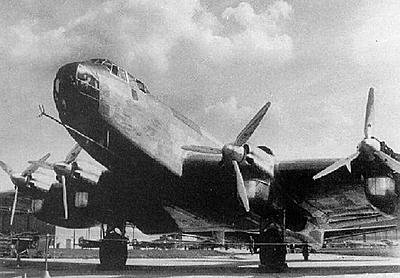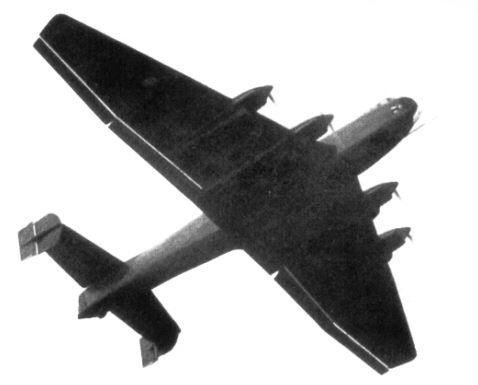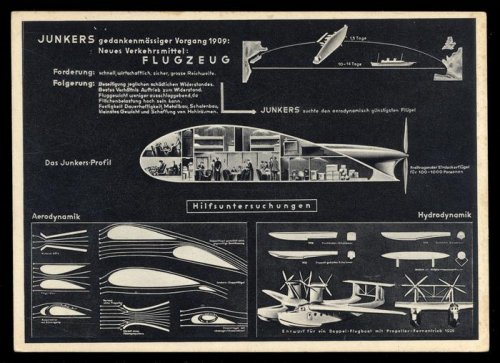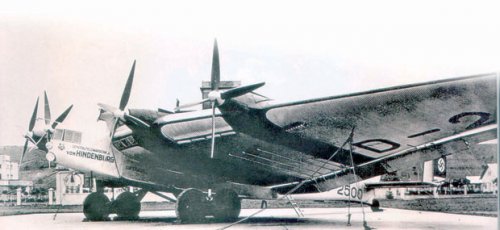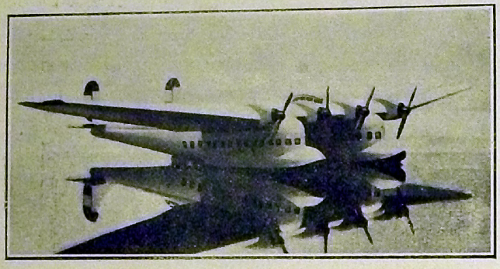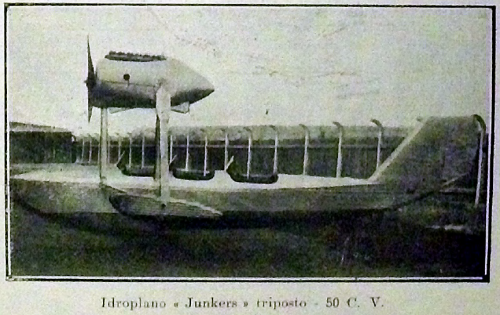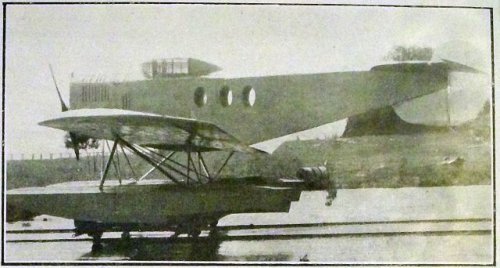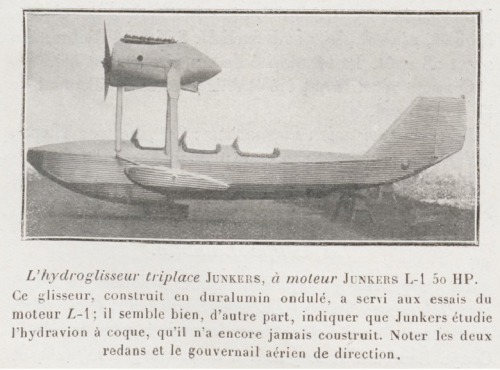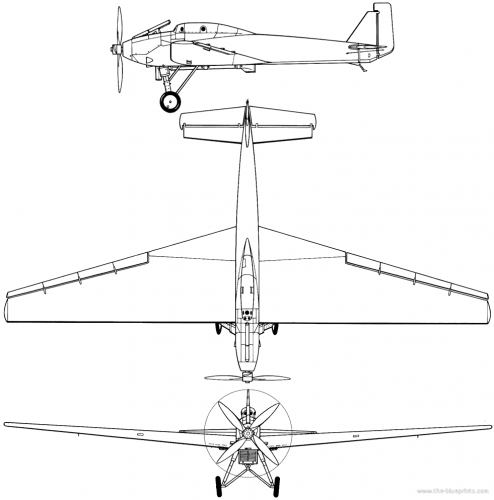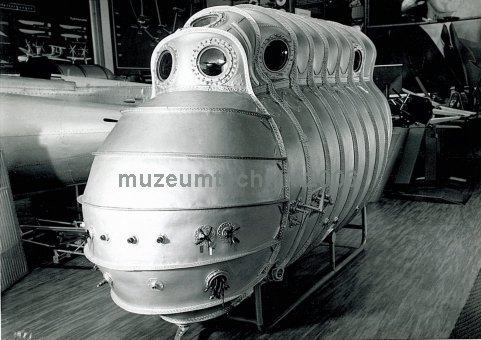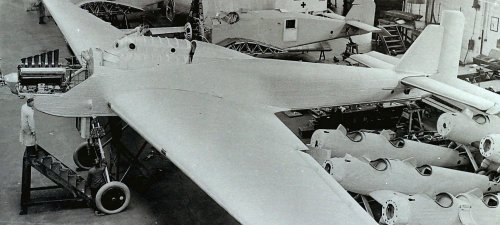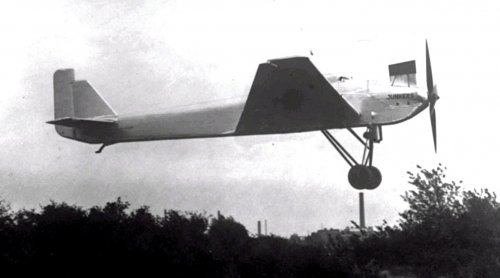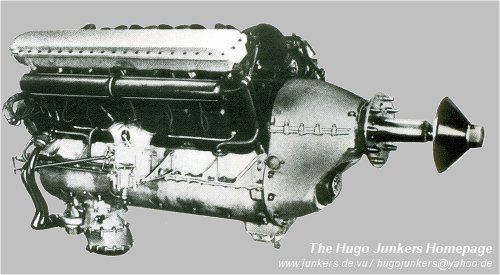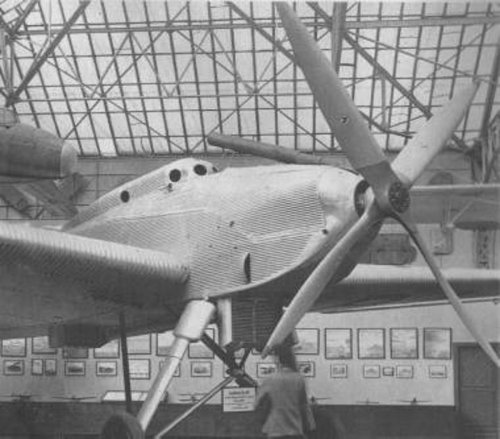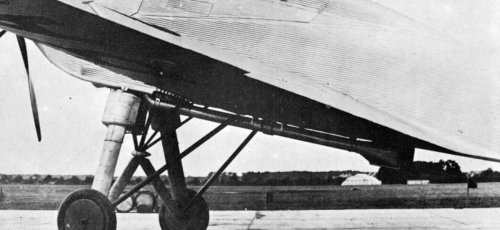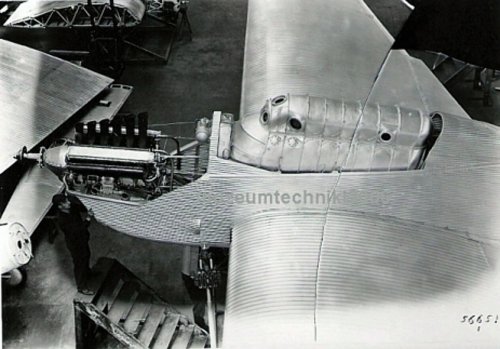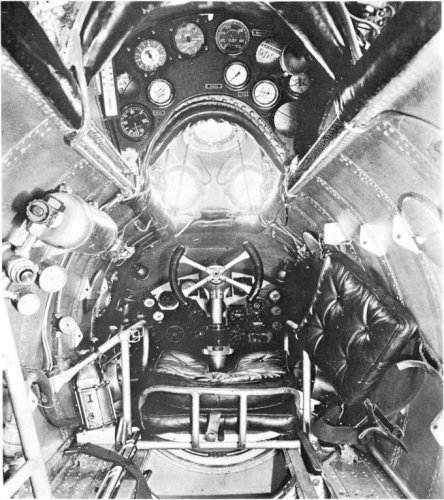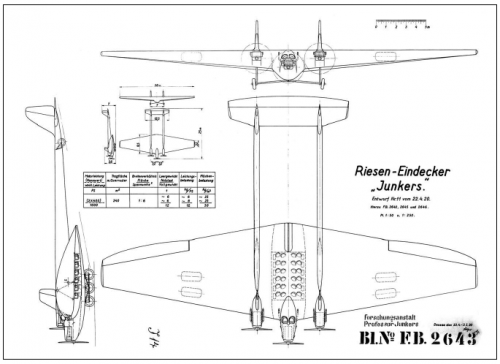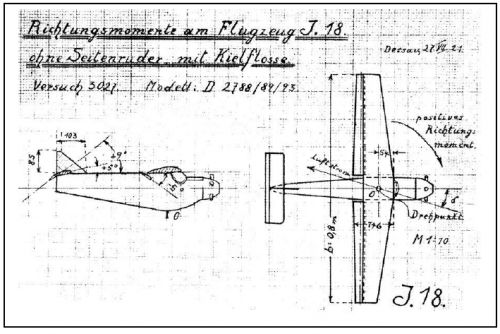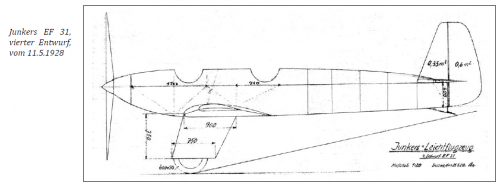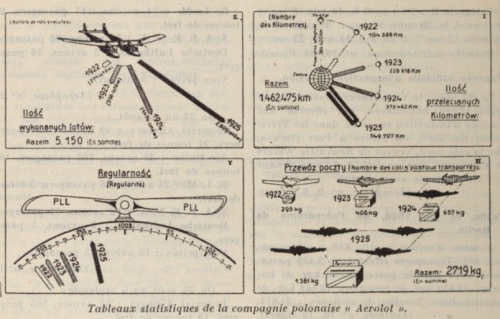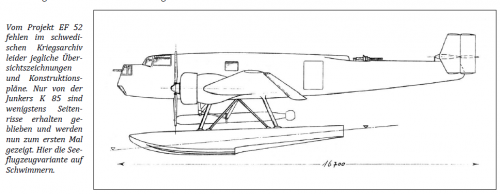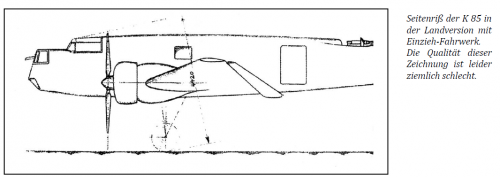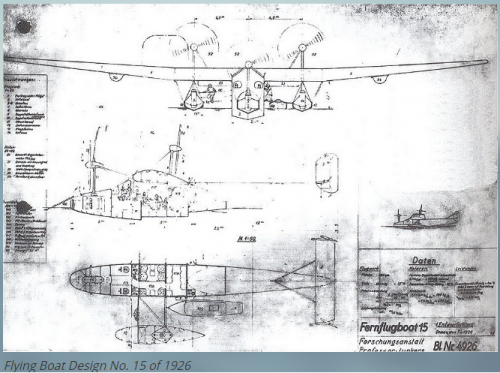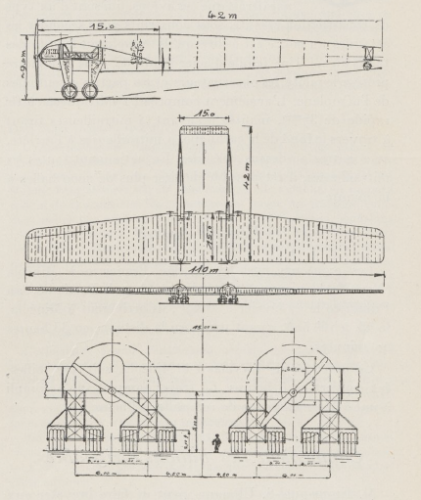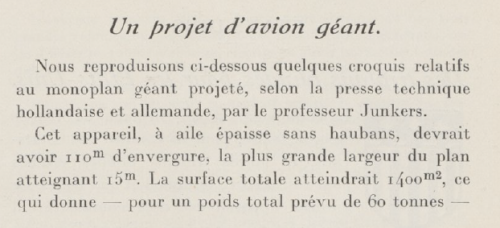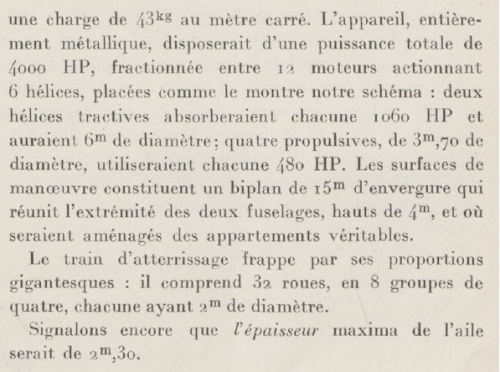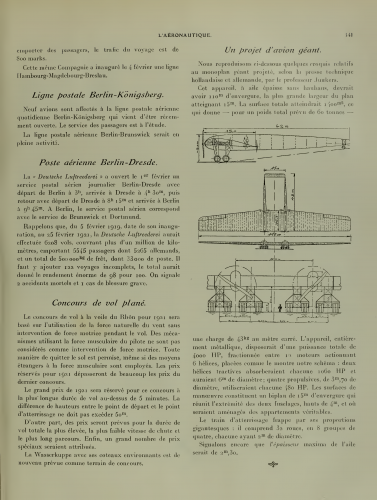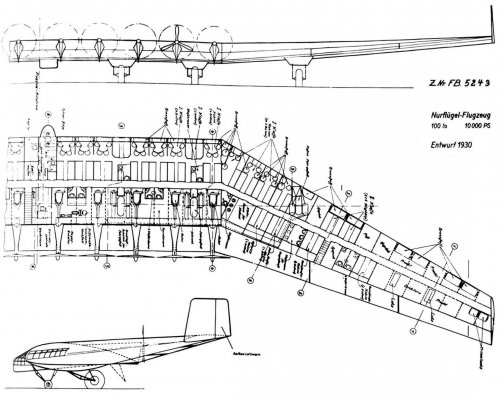Junkers Projects and Prototypes 1919 - 1939
- Thread starter raravia
- Start date
- Joined
- 11 March 2006
- Messages
- 8,628
- Reaction score
- 3,834
The aircraft somehow looks like a Ju 86, so maybe those bubbles were proposed
for a pressurised high-altitude version ? The plan view gives the impression (at least
to me), that there are only bubble windows, but the detail drawing seem to show a
framed windscreen and for aircraft with conventional cockpit glazing, there seem not
to have been much need for such allround visibility.
for a pressurised high-altitude version ? The plan view gives the impression (at least
to me), that there are only bubble windows, but the detail drawing seem to show a
framed windscreen and for aircraft with conventional cockpit glazing, there seem not
to have been much need for such allround visibility.
- Joined
- 25 June 2009
- Messages
- 14,767
- Reaction score
- 6,206
gerhard said:Does anyone have information on the Ju.89 and Ju.90?
Junkers Ju 89
When Lieutenant General Walter Wever completed the development of specifications for the heavy "Uralbomber", he met with rather powerful opposition from the planning department staff, which questioned the need for such an aircraft. Despite the doubts, the Technical Department of the Air Ministry issued an order for "Uralbomber" designs from Dornier and Junkers in the summer of 1935 and in early autumn three prototypes were ordered, designated the Do 19 and Ju 89, respectively.
Designer Ernst Tsindel heavily rested on experience gained in creating the Ju 86 to create the Ju 89. The design used duralumin, as well as chromium-molybdenum steel for the ordnance compartments. The fuselage was monocoque with a square section, reinforced frames and stringers, and an elliptical top fairing. The wing consisted of five sections. The center section was built in one piece with the fuselage and had five spars. The inner section had five main and two auxiliary spars, while the outer had four main and three auxiliary ones. Flaps were similar to those of the tandem wing Junkers and consisted of two sections. The main landing gear units were retracted hydraulically within the rear of the nacelles.
The power plant consisted of four Junkers Jumo-211A or four Daimler-Benz DB-600A engines, all 12-cylinder, liquid-cooled types. Provision was made for a crew of nine people: two pilots, a radio operator, a bombardier, a flight engineer and five gunners. Defensive armament consisted of one gun in the forward fuselage, the same gun in the rear installation and guns in the upper and lower hydraulically-controlled twin turrets. In the bomb bay, the vertical hanger could accomodate sixteen 100-kg or thirty-two 50-kg bombs.
The first two prototypes, designated Ju 89 V1 and V2 were already in very advanced stages of construction when Lieutenant General Wever was killed in a plane crash on June 3, 1936. The premature death of the chief proponent of heavy bombers led to the nomination of Albert Kesselring, who opposed the construction of strategic aviation at this stage of development of the Luftwaffe, which he believed came at the expense of tactical aircraft. This was the main reason for discontinuing work on Ju 89 and its competitors Do 19 after Wever's death.
However, the Technical Department protested, in the person of bomber aircraft Inspector General Kurt Pflugbeil, who believed that the decision was shortsighted and pushed the case directly to Hermann Goering, expecting support from him. The insistence of the Technical Department allowed for work to continue on the prototypes but Goering knew that Hitler would ask him how many bombers there were, not how big they were... and instead of two four-engined bombers, three twin-engine bombers could be built instead. At that time the whole bomber program was revised and Tsindel had doubts about the possibility of continuing the "Uralbomber" program under the revised requirements and new specifications issued in November 1936 for the so-called Bomber "A" (just a few weeks before the first flight Ju 89 V1). As a result, the chief designer made a request to complete the incomplete Ju 89 V3 as a commercial transport aircraft instead. After five months the "Uralbomber" program was finally discontinued.
Ju.89 V1 (D-AFIT) flew in December 1936. It was equipped with four 1075hp Jumo 211A engines rated at 2300 rpm, with Junkers-Hamilton airscrews. The tests revealed some directional instability, which led to a redesigned tail. Simultaneously, additional air intakes were installed under the outboard engines. Ju.89 V2 (D-ALAT) started tests in early 1937. Its main difference was the use of four 960hp DB-600A engines rated at 2350 rpm with VDM airscrews. By this time work had begun on alteration the third Ju 89 V3 as the transport Ju 90. The V3 had been designed with double Mauser turrets, and they had already been installed on the aircraft when the RLM issued permission to use the wings, engines, landing gear and tail for the Ju 90 V1 instead.
Flight tests of Ju 89 V1 and V2 continued until the official termination of the program on April 29, 1937. Both served as test vehicles for the development of commercial aircraft. In the summer of 1938 two records were set for lifting a 5000-kg load at 9318m altitude and 10000-kg at 7246m, officially by the Ju 90 V1, but probably by the V2 instead, as the V1 actually crashed four months earlier, on Feb. 6, during a flutter test in which a rear auxiliary 400hp engine had been installed drives the vibrator. The loss of control over it led to uncontrolled oscillatory mode and crash. Later prototypes were converted into transports and as such used during landings of Norway as part of KG.zbV105.
Attachments
- Joined
- 11 March 2006
- Messages
- 8,628
- Reaction score
- 3,834
The book "Die grossen Dessauer: Junkers Ju 89, Ju 90, Ju 290, Ju 390.
Die Geschichte einer Flugzeugfamilie" by Karl Kössler could be an interesting
source for you, I think. Unfortunately I cannot put my hand on it in the moment,
but could send you a number of scans at the beginning od December, if that
isn't too late for you.
Die Geschichte einer Flugzeugfamilie" by Karl Kössler could be an interesting
source for you, I think. Unfortunately I cannot put my hand on it in the moment,
but could send you a number of scans at the beginning od December, if that
isn't too late for you.
The Junkers A50 modified long range aircraft, as reported above, was quite a bizarre and extreme modification, it would seem. the extreme increases reported are shocking.
Junkers OWN performace specifications (*from Original Junker A50 catalogue and brochure) were for an aircraft that cruised at a mere 140km(only 87mph)
the Range: 600km or 372 miles
and the claim above would appear to be for 11,404 km, range. upgraded from 600 km in normal configuration.,
and from 5 hours endurance range to 80!? does not seem possible, without multiple episodes of in-flight re-fueling. Was this the case?
Junkers OWN performace specifications (*from Original Junker A50 catalogue and brochure) were for an aircraft that cruised at a mere 140km(only 87mph)
the Range: 600km or 372 miles
and the claim above would appear to be for 11,404 km, range. upgraded from 600 km in normal configuration.,
and from 5 hours endurance range to 80!? does not seem possible, without multiple episodes of in-flight re-fueling. Was this the case?
- Joined
- 11 March 2006
- Messages
- 8,628
- Reaction score
- 3,834
Differentiation may sometimes be a bit dificult here. I would regard the Ju 52 clearly as an interwar
type, as it actually was in wide use before the start of the war. On the other hand, the Ju 88, although
flown before the outbreak of war, I would rather count as appropriate for the "Junkers Projects and
Prototypes of WW I" thread.
type, as it actually was in wide use before the start of the war. On the other hand, the Ju 88, although
flown before the outbreak of war, I would rather count as appropriate for the "Junkers Projects and
Prototypes of WW I" thread.
richard
ACCESS: Top Secret
- Joined
- 1 May 2006
- Messages
- 578
- Reaction score
- 144
Interesting pictures here :
Philasearch.com: Briefmarken, Ganzsachen und Ansichtskarten
Particularly this one :
Philasearch.com: Briefmarken, Ganzsachen und Ansichtskarten
Particularly this one :
Attachments
- Joined
- 11 March 2006
- Messages
- 8,628
- Reaction score
- 3,834
Interesting site indeed, thanks for pointing us to it !
That flying wing resembles very much this one http://www.secretprojects.co.uk/forum/index.php/topic,177.msg1006.html#msg1006,
but it is described as "gedankenmäßiger Vorgang 1909", nowadays we would say, concept or idea
1909, whereas the J 1000 is stated to be from around 1919 !
That flying wing resembles very much this one http://www.secretprojects.co.uk/forum/index.php/topic,177.msg1006.html#msg1006,
but it is described as "gedankenmäßiger Vorgang 1909", nowadays we would say, concept or idea
1909, whereas the J 1000 is stated to be from around 1919 !
- Joined
- 11 March 2006
- Messages
- 8,628
- Reaction score
- 3,834
"From Flugzeug 4/1993,
here is a Junkers EF.122 two Models."
I've moved this post to the thread about the Ju 287, including the pre-projcets.
( http://www.secretprojects.co.uk/forum/index.php/topic,8886.msg244530.html#msg244530 )
Wasn't really a project of the 1919 - 1939 era either ...
here is a Junkers EF.122 two Models."
I've moved this post to the thread about the Ju 287, including the pre-projcets.
( http://www.secretprojects.co.uk/forum/index.php/topic,8886.msg244530.html#msg244530 )
Wasn't really a project of the 1919 - 1939 era either ...
- Joined
- 26 May 2006
- Messages
- 34,945
- Reaction score
- 15,835
c460 said:The Junkerissime, not posted yet. The description is from the Spanish magazine Aérea, Apr. 1924.
(The image is a better copy found on the web.)
The Junkerissime;
http://www.avia-it.com/act/biblioteca/periodici/PDF%20Riviste/Ala%20d'Italia/L'ALA%20D'ITALIA%201922%20011.pdf
Attachments
- Joined
- 26 May 2006
- Messages
- 34,945
- Reaction score
- 15,835
hesham said:What was this Junkers aircraft ?,from Gallica,l'Aeronautique 1923.
Still mystery,I want to ID this beast;
http://www.avia-it.com/act/biblioteca/periodici/PDF%20Riviste/Ala%20d'Italia/L'ALA%20D'ITALIA%201923%20011-012.pdf
Attachments
- Joined
- 11 March 2006
- Messages
- 8,628
- Reaction score
- 3,834
The first one to my opinion isn't a Junkers type at all, but (as written in that article !) a LFG design,
fitted with a Junkers engine. Could well be the metal version of the LFG V20 mentioned here
https://en.wikipedia.org/wiki/LFG_V_20
Again, asking a native Italian speaker for help isn't embarrassing or defamatory, there may be clues
to that hydroplane (which to my opinion is just using a Junkers engine), too.
fitted with a Junkers engine. Could well be the metal version of the LFG V20 mentioned here
https://en.wikipedia.org/wiki/LFG_V_20
Again, asking a native Italian speaker for help isn't embarrassing or defamatory, there may be clues
to that hydroplane (which to my opinion is just using a Junkers engine), too.
- Joined
- 26 May 2006
- Messages
- 34,945
- Reaction score
- 15,835
hesham said:What was this Junkers aircraft ?,from Gallica,l'Aeronautique 1923.
But it mentioned also by French L'Aeronautique in 1923,please see this again.
Attachments
- Joined
- 3 September 2006
- Messages
- 1,476
- Reaction score
- 1,475
It is worth noting that the French word used is hydroglisseur, not hydravion. That means the contraption is not meant to fly, but to glide on the water.
I think the closest word in English would be airboat. Hydravion of course is seaplane or flying boat.
That explains why the thing has no horizontal tail surfaces.
Further, the text says explicitly that this airboat was used to test the engine, with a view to developing a real flying boat (hydravion).
I think the closest word in English would be airboat. Hydravion of course is seaplane or flying boat.
That explains why the thing has no horizontal tail surfaces.
Further, the text says explicitly that this airboat was used to test the engine, with a view to developing a real flying boat (hydravion).
- Joined
- 6 November 2010
- Messages
- 5,266
- Reaction score
- 5,526
It seems to have no wings either.dan_inbox said:That explains why the thing has no horizontal tail surfaces.
blackkite
Don't laugh, don't cry, don't even curse, but.....
- Joined
- 31 May 2007
- Messages
- 8,822
- Reaction score
- 7,725
Hi Ju-49.
https://en.wikipedia.org/wiki/Junkers_Ju_49
"The engine was the Junkers L88a, which combined two six-cylinder inline L8 motors into an upright V-12 and had a two-stage supercharger plus intercooler to sustain power at high altitudes.
The supercharged engine was not cleared for use at the time of the first flight on October 19 and the Ju 49 used instead the unsupercharged L88 version. Externally this installation was characterised by a tall, inline vertical stack of exhausts, unlike the single sloping pipe of the L88a. By summer 1932, the supercharged engine was flight-ready and installed, and the research program proper began. This was uneventful, with no serious engine or cabin problems."
https://www.the-blueprints.com/blueprints-depot/ww2planes/junkers/junkers-ju-49.png
What is the bottom pipe?
Junkers L88 engine.
http://hugojunkers.pytalhost.com/ju_l88_a1.htm
https://en.wikipedia.org/wiki/Junkers_Ju_49
"The engine was the Junkers L88a, which combined two six-cylinder inline L8 motors into an upright V-12 and had a two-stage supercharger plus intercooler to sustain power at high altitudes.
The supercharged engine was not cleared for use at the time of the first flight on October 19 and the Ju 49 used instead the unsupercharged L88 version. Externally this installation was characterised by a tall, inline vertical stack of exhausts, unlike the single sloping pipe of the L88a. By summer 1932, the supercharged engine was flight-ready and installed, and the research program proper began. This was uneventful, with no serious engine or cabin problems."
https://www.the-blueprints.com/blueprints-depot/ww2planes/junkers/junkers-ju-49.png
What is the bottom pipe?
Junkers L88 engine.
http://hugojunkers.pytalhost.com/ju_l88_a1.htm
Attachments
- Joined
- 13 August 2007
- Messages
- 8,477
- Reaction score
- 11,122
blackkite said:Hi Ju-49.
https://www.the-blueprints.com/blueprints-depot/ww2planes/junkers/junkers-ju-49.png
What is the bottom pipe?
it must be part of the Supercharger
early picture of Ju-49 not feature this pipe, later the Engine was supercharged and picture from that time feature the pipe

picture taken 1 October 1931
blackkite
Don't laugh, don't cry, don't even curse, but.....
- Joined
- 31 May 2007
- Messages
- 8,822
- Reaction score
- 7,725
Ummm.......Thansk a lot. 
http://www.airwar.ru/enc/xplane/ju49.html
"In the year 1928 Professor Hugo Junkers received an order from the Deutschen Versuchsanstalt für Luftfahrt "(DVL) on the development of experimental high-altitude surveillance aircraft. Design and construction work lasted for three years and only in the autumn of 1931 year aircraft receiving the designation Ju 49 was ready. It was a cantilever monoplane with low wing clad corrugated iron and the ailerons "double wing", which was first applied in the year 1925 the company had 4 holders. The powerplant consisted of one aircraft Junkers L88a engine with power of 800 HP for the applicability of the chetyrehlopastnyj propeller with a diameter of 5.60 meters. Such a big screw diameter made significantly lengthen landing gear.
October 2, 1931 year aircraft Ju 49 (serial number 3701, registration D-2688) made its first flight. The following year, the aircraft has undergone several improvements, and only two years later, in September 1933 year DVL took flight. This year the aircraft was able to climb up to a height of 9300 meters, and in 1935 (with the new registration number D-UBAZ obtained in the year 1934)-height of 12500 meters. A single instance of the Ju 49 was lost in an accident in the year 1936."
http://www.airwar.ru/enc/xplane/ju49.html
"In the year 1928 Professor Hugo Junkers received an order from the Deutschen Versuchsanstalt für Luftfahrt "(DVL) on the development of experimental high-altitude surveillance aircraft. Design and construction work lasted for three years and only in the autumn of 1931 year aircraft receiving the designation Ju 49 was ready. It was a cantilever monoplane with low wing clad corrugated iron and the ailerons "double wing", which was first applied in the year 1925 the company had 4 holders. The powerplant consisted of one aircraft Junkers L88a engine with power of 800 HP for the applicability of the chetyrehlopastnyj propeller with a diameter of 5.60 meters. Such a big screw diameter made significantly lengthen landing gear.
October 2, 1931 year aircraft Ju 49 (serial number 3701, registration D-2688) made its first flight. The following year, the aircraft has undergone several improvements, and only two years later, in September 1933 year DVL took flight. This year the aircraft was able to climb up to a height of 9300 meters, and in 1935 (with the new registration number D-UBAZ obtained in the year 1934)-height of 12500 meters. A single instance of the Ju 49 was lost in an accident in the year 1936."
Attachments
- Joined
- 26 May 2006
- Messages
- 34,945
- Reaction score
- 15,835
c460 said:The Junkerissime, not posted yet. The description is from the Spanish magazine Aérea, Apr. 1924.
(The image is a better copy found on the web.)
Hi,
http://gallica.bnf.fr/ark:/12148/bpt6k97675232.r=document%20aeronautique?rk=21459;2
Attachments
- Joined
- 26 May 2006
- Messages
- 34,945
- Reaction score
- 15,835
hesham said:From the site which discover by my dear Jemiba;
http://www.draco-server.de/ADL/doc/Junkers_EF-Nummern.pdf
The Junkers EF.52 or K85.
Attachments
- Joined
- 26 May 2006
- Messages
- 34,945
- Reaction score
- 15,835
hesham said:
Hi,
http://hugojunkers.bplaced.net/junkers-j40.html
Attachments
- Joined
- 5 May 2007
- Messages
- 351
- Reaction score
- 410
Here is British Pathe newsreel featuring a Deutsche Luft Hansa (DLH) Junkers Ju 90 (JU 90 V3, reg. D-AURE, c/n 4915, "Bayern") performing a flight demonstration. As one of the Ju 90 prototypes, D-AURE retained the wing of the Ju 89 with a swept leading edge (unlike the predominantly straight wing used by the Ju 90 V5, and later variants) .
YouTube - British Pathé: "Flying Hotel - Germany" (1938)
https://www.youtube.com/watch?v=vW5IT7fAP3A
YouTube - British Pathé: "Flying Hotel - Germany" (1938)
https://www.youtube.com/watch?v=vW5IT7fAP3A
gabrielorosco
I really should change my personal text
- Joined
- 10 December 2016
- Messages
- 194
- Reaction score
- 235
- Joined
- 11 March 2006
- Messages
- 8,628
- Reaction score
- 3,834
Here, too, mentioning the source would be great, both as easing further research, as well as
it should be natural to give credit to the original source.
Interesting scheme, nevertheless, with a span of 110 m, it would have been just slightly less, than
Stratolaunch ! Interesting, too, the combination of two big props in the nose of the booms with four
smaller ones at the trailing edges.
it should be natural to give credit to the original source.
Interesting scheme, nevertheless, with a span of 110 m, it would have been just slightly less, than
Stratolaunch ! Interesting, too, the combination of two big props in the nose of the booms with four
smaller ones at the trailing edges.
gabrielorosco
I really should change my personal text
- Joined
- 10 December 2016
- Messages
- 194
- Reaction score
- 235
Unfortunately, I don't have the source. I found those images here in SPF...nothing more. Thanks!
Jemiba said:Here, too, mentioning the source would be great, both as easing further research, as well as
it should be natural to give credit to the original source.
Behold the wonders I give unto you:
https://archive.org/details/la02b9eronautiqu03pari/page/n2
Includes a PDF scan hundreds of pages in length, just the thing to fill that "I wonder what the world of aeronautics was like just after WWI" urge.
Attachments
gabrielorosco
I really should change my personal text
- Joined
- 10 December 2016
- Messages
- 194
- Reaction score
- 235
Retrofit said:Cy-27 said:Junkers Project 14 - Junkers "Ju.Y" - 100 ton transport project.
As with the Ju.X, no company records exist for the designation of this project in the Junker Dessau archive so Schmitt allocated "Ju.Y" to this type. The outline design plan carried the reference "F.B.5243" and "Nurflugel-Flugzeug".
It was a 1930 design for a giant transport flying wing. It was to have ten diesel engines integrated into the thick middle wing area. It was to have an intermediate transmission and extension shaft to drive the ten pusher propellers located in the trailing wing.
Does anybody has any more info on this giant junkers flying wing? Such as especifications, and more images
thanks
Thanks for all those information, Cy-27!
Here-under a drawing of the project Y from the book "Nurflügel" by R. Horten and P. Selinger (H. Weishaupt Verlag-1985).
gabrielorosco
I really should change my personal text
- Joined
- 10 December 2016
- Messages
- 194
- Reaction score
- 235
- Joined
- 11 March 2006
- Messages
- 8,628
- Reaction score
- 3,834
In Rudolf Storck "Flying Wings" (Bernard & Graefe publishing) it's mentioned as Projekt Nr. FB 5243
from 1930, no more data, but perhaps that's an additional clue/keyword for further research.
from 1930, no more data, but perhaps that's an additional clue/keyword for further research.
gabrielorosco
I really should change my personal text
- Joined
- 10 December 2016
- Messages
- 194
- Reaction score
- 235
Jemiba said:In Rudolf Storck "Flying Wings" (Bernard & Graefe publishing) it's mentioned as Projekt Nr. FB 5243
from 1930, no more data, but perhaps that's an additional clue/keyword for further research.
Thank you, my dear friend. I'll use this new information
Cheers
sgeorges4
I really should change my personal text
- Joined
- 8 October 2017
- Messages
- 665
- Reaction score
- 334
junkers 52 designation from the hugo junkers website :
Does anyone know why the Ju52/3mg13e designation was never used?
blackkite
Don't laugh, don't cry, don't even curse, but.....
- Joined
- 31 May 2007
- Messages
- 8,822
- Reaction score
- 7,725
Hi! JG1.
"When the F13 design was finished, Junkers returned to the idea of a large all-metal aircraft for passenger transport purposes. The initial Junkers J14 was a ten seater Commercial airliner with a cabin of four seat rows with two seats in each row. It should have been powered by two Daimler or BMW IIIa engines with 160PS or 185 PS each. The first drawings Show a date of July 1919 for the J14. But the J14 seems to have been abandoned very early for a new four engine design.
This design was designated as JG1 of 1920. Several approaches were discussed to design a high-, mid- and cantilever monplane, but due to aerodynamic troubles, finally a highlevel monoplane was designed. The JG1 should have been equipped with four 260 PS engines, making it capable to fly with still two engines at an altitude of 1000 meters at 110 km/h. Developments of the JG1 started in summer 1920. In January 1921 the prototype construction was initiated.
The outer wing and the rear parts of the fuselage were already finished, when the Allied supervisory board discovered the JG1 during its investigations at Junkers Flugzeugwerke in the beginning of 1921. Junkers was advised to destroy these JG1 parts due to the construction limitations in Germany."

 www.junkers.de
www.junkers.de
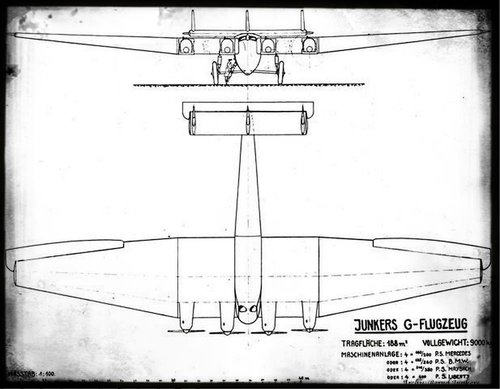
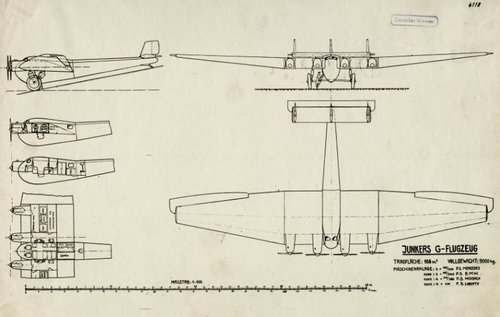
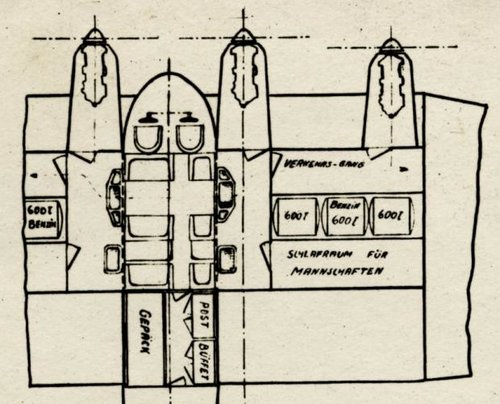
"When the F13 design was finished, Junkers returned to the idea of a large all-metal aircraft for passenger transport purposes. The initial Junkers J14 was a ten seater Commercial airliner with a cabin of four seat rows with two seats in each row. It should have been powered by two Daimler or BMW IIIa engines with 160PS or 185 PS each. The first drawings Show a date of July 1919 for the J14. But the J14 seems to have been abandoned very early for a new four engine design.
This design was designated as JG1 of 1920. Several approaches were discussed to design a high-, mid- and cantilever monplane, but due to aerodynamic troubles, finally a highlevel monoplane was designed. The JG1 should have been equipped with four 260 PS engines, making it capable to fly with still two engines at an altitude of 1000 meters at 110 km/h. Developments of the JG1 started in summer 1920. In January 1921 the prototype construction was initiated.
The outer wing and the rear parts of the fuselage were already finished, when the Allied supervisory board discovered the JG1 during its investigations at Junkers Flugzeugwerke in the beginning of 1921. Junkers was advised to destroy these JG1 parts due to the construction limitations in Germany."

Der Konstrukteur Otto Reuter - Junkers
Vor 90 Jahren starb in Dessau ein junger Ingenieur, der zu den begabtesten Mitarbeitern von Prof. Junkers gehörte. Weltweit bekannt geworden ist er als der Konstrukteur des ersten reinen Verkehrsflugzeuges in Ganzmetallbauweise, der Junkers F 13. Dabei hatte ihn Professor Junkers überhaupt nicht...



| Aircraft | year | engine | length in m | span in m | wing area im sqm | net weight in kg | payload in kg | seats | speed in km/h | range in km |
|---|---|---|---|---|---|---|---|---|---|---|
| J14 JG 1 | 1919 1921 | 2xBMW IIIa (160PS) 4xBMW IV (184kW) | 12,90 18,00 | 24,30 37,60 | 187,50 | 4930 | 4070 | 2+8 2 pilots + 9 pass. | 200 | 2500 |
Last edited:
Similar threads
-
-
Civilian Heinkel Projects and Prototypes
- Started by hesham
- Replies: 9
-
-
FVA Early Canard Aircraft and Projects from Germany
- Started by hesham
- Replies: 9
-
Projects of the German Secret Flight Test Center at Lipetsk, USSR 1924-1933
- Started by Dynoman
- Replies: 37


